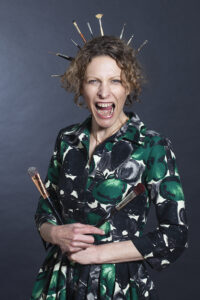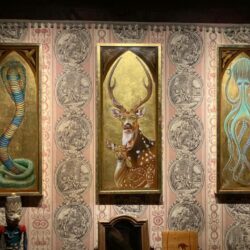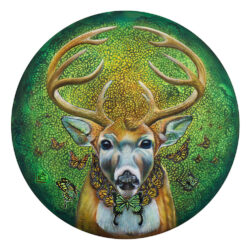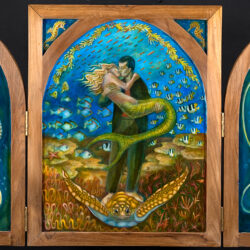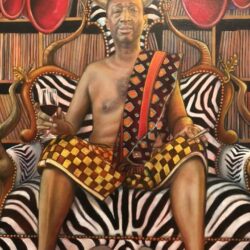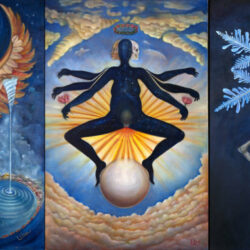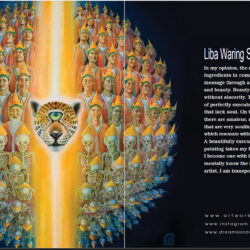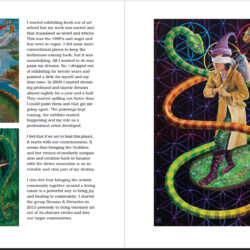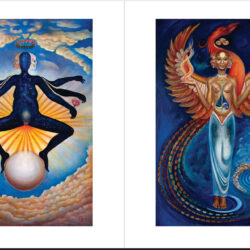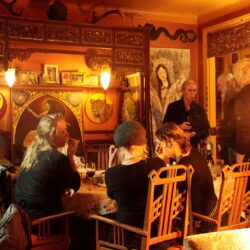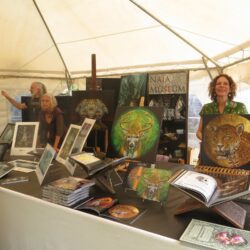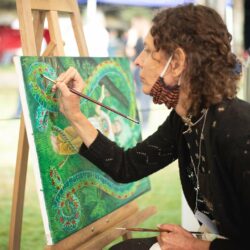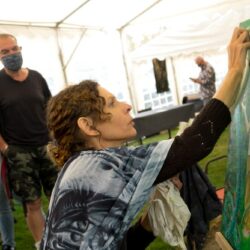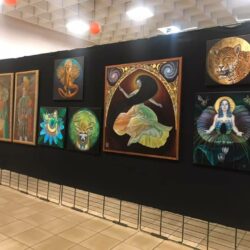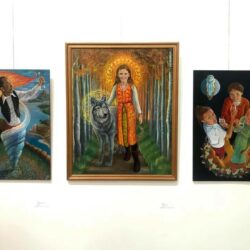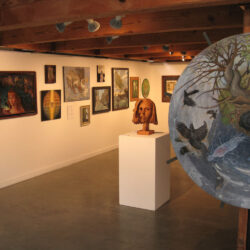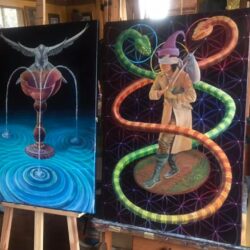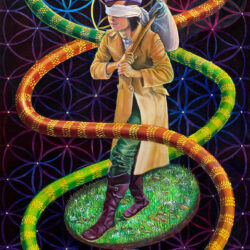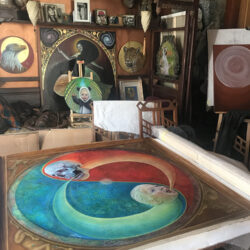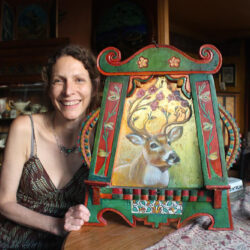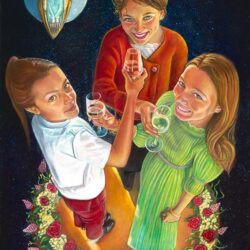Q: How are you inspired to create the powerful and compelling art you are known for?
Do you begin with a theme in mind, or does it emerge while you are working? What inspires your work, the current political conditions, the environment, the books you read, your dreams, or a conversation with a friend… In other words… does your inspiration come more from internal or external sources?
A: I do two types of painting:
In the first case, I paint subjects that have to be painted: stories and dreams that are overflowing into my waking world and demanding representation.
Translating a dream sequence into a still image requires deep introspection vis a vis the dream. When constructing the composition, I am careful to bring in the symbols that best give the message and a composition which best describes the mood of the painting. It is an ongoing process. As I paint a dream, I comprehend it better. I relive it in a sense, but with a much more profound sense of understanding. Other symbols will appear. Colors will be influenced.
For fun, I did a series of ten self-portraits morphed with my Totem animals. Totem animals to me, represent different human characteristics like joyfulness, courage, insight etc… They are represented by animals who I have chosen for various different reasons: either I dreamt about them or I have pulled them consistently from my Medicine card deck (an oracle deck).
I also included a Heron because I had a strong connection with a wounded heron that my husband and I found in the woods. It trusted us and the huge bird let me hold it in my lap as we drove for an hour to a wildlife vet. The ten portraits were exhibited in Seattle’s Krab Jab Gallery in a three person show with Carrie Ann Baade and Patrick McGrath.
This brings me to the second type of work I do: Work that has been requested of me. The animal portraits made a bit of a splash and I started getting orders for portraits. This is extremely fun to do especially if I know the model, because one has an intimate relationship with the subject when morphing their eyes with a creature. I am also asked to paint other people’s dreams or visions. Again, this is a magical experience because the collector is allowing me to partake in their personal and transformative experience.
Last but not least, I sometimes create work for specific shows which have a theme. In order for me to be inspired for a themed show I have to sincerely be into it. Often I already have a painting which corresponds to the show but if I don’t and the theme speaks to me, I will make a specific piece eg: the Apocalypse show, at the French chimeria bienalle, inspired a painting that came to me visually, from the moment I was invited. It might never have been painted had it not been for that show. It also found a home before it was even finished!
Q: What does an image need to have to express or inspire a shift in awareness?
A: In my opinion, the most important ingredients in communicating a message through art is: Sincerity and beauty. Beauty cannot exist without sincerity. There are lots of perfectly executed paintings which lack soul. On the other hand, there are amateur, naïve, paintings which are very soulful paintings, and which resonate with me completely. A beautifully executed soulful painting takes my breath away. I become one with it even if I don’t mentally know the intention of the artist, I am transported.
Q: What do you look for in a model or muse? What qualities are a must? (if this is not relevant to your work you can skip this question).
A: All my muses are my friends, family or myself. Because I find all my friends and family beautiful, I have fun translating that onto canvas.
Q: Is there any Artist, living or dead who has inspired you to be more passionate as an artist?
A: So many artists passionately inspire me!
I adore the early to late Renaissance. The Flemish amaze me…Holbein is one of my faves and for the Italians, a good Botticelli is just delicious. I love Aboriginal art, outsider art, every type of art, if it is beautiful. I admire Frida Kahlo for doing her thing despite her gender in a time not made for women. In a body not made for such genius. I love her. Today in my contemporary circles, there are so many artists I love that I put together a non-profit artist’s group to celebrate conscious art! It is called Dreams and Divinities. I am completely inspired by my community and the current outpouring of loving consciousness manifesting in beauty.
Q: Do you need to have the right environment or setting to create a powerful image? If so, what preparations do you make to prepare the surroundings you work in?
A: I my opinion, wherever one feels comfortable is the best place to work. I had been offered free use of a professional artist studio in the suburbs of Paris. but I work all day and also at night. I simply don’t want to be away from home for so much of my life. I have the great fortune of having enough space to paint and work at home in Paris or in the forest in a safe cozy environment with good music and a family I love nearby..
Q: Due to the pandemic, and recent political upheaval (in some countries) there seems to be a need for a new perspective. A New Beginning, Rebirth, A Clean Slate, The Advent of Something Better…. Do you feel it is the artists duty to inspire change? If so in what way do you hope to make a difference in your community or the world at large?
A: I feel that each one of us needs to live the change we are looking for. We need to be conscious of all our decisions and the impacts they make. Therefore, yes with artists as well. I was so thrilled to discover a planetary community of artists expressing consciousness that this inspired me to create my group Dreams & Divinities. This group started centered around books that assembled artwork around a theme. But Life had other ideas for us and cities invited us to do events, museums invited us to exhibit, Indigenous Indians and eco villages reached out to us to form coalitions. When covid hit I organized online galleries for festivals and eventually for my own web site. Since 2013 I have organized us into 28 events. These events were free for the public. They brought this niche, little known genre of conscious art to a public who might never have seen it if they didn’t frequent the little world that was making it.
I am currently working on a Tarot deck project. The cards are being painted by Martina Hoffmann, Carrie Ann Baade, Michel Bassot and myseslf. I started writing the book that will accompany the deck about three years ago. I was familiar with Kaballah and saw the obvious connection to the Tarot and the Kabbalistic tree which I list below:
22 letters -22 major arcanas
10 spheres – Ace to ten (for each suit making forty cards)
The letters are made up of the 4 elements and the way they interact affects the system – the suits and the courtcards are made up of the 4 elements and the way they interact affects the system.. eg: watery fire = Queen of clubs, airy fire = King of clubs, earthy fire = Princess of Clubs and fire of fire – = Prince of Clubs. Of course this is done with each suit making 4×4=16 courtcards.
The general idea was clear enough from the start but I didn’t know enough about Kaballah to identify each card. The more I looked and the more I studied, the more contradictions I kept finding within the Tree itself and how the cards related to the Tree. Meanwhile I was dreaming about the Tree and I knew that somewhere there had to be an original text at the foundation of this system which portrayed a logical and coherent symbolic Tree. And then I found it: The Sefer Yetzirah, which literally means Book of Creation. This document of around ten pages, is attributed to the mythological Abram: Patriarch of Judaism, Christianity and Islam. The text was originally a hermetic oral tradition so we cannot verify its age, but it is mentioned in the Babylonian Talmud which means it was already around at the beginning of the first millennium ce. Thus, the original description of a system or a Tree made of ten spheres and twenty-two letters predates Cordovero’s first symbolic tree in the Renaissance, by over 1000 years. Based on my research, the philosophy of the system, dates it even further back.
The Genesis story of the Abrahamic religions put the woman at the centre of the Fall. She is the sinner not to be trusted, along with the snake and the fruit of ‘the Tree’.(In Proverbs 3:18
of the Torah, the Tree of Wisdom is associated with Chokma, Goddess of Wisdom. Chokma is not only a Godess like the Gnostic Sophia, but a female noun in Hebrew. But even within the fairly balanced Kabbalistic system she lost her position to the masculine. For the Supernal Father in Renaissance and modern Kabbalism is named Chokma.
The Sefer Yetzirah which is also attributed to Abraham, describes a Genesis with three Mothers, who birth the first three Fathers. The three pairs go on to unfold creation with 7 and then 12 more letters and their manifestations as Time, Space and Soul. 3+7+12=22 letters. These twenty-two letters make up the name of the Goddess. Their manifestation as Time, Space and Soul make up the body of the Living God.
The numerical spheres give the element of time to the system. Therefore the genesis starts in sphere 1, known as the beginning, with a primordial Mother named Aleph. She breathes the first breath which is the first father. Breath is the father, Aleph is the breather and they manifest as the chest and neutrality in the body/soul. As ‘Time’ they manifest as the temperate seasons and as ‘Space’ they manifest as Air. Even though Breath is Aleph’s consort and the Sefer Yetzirah asks us to count them as one pair not individually, Breath impregnates Aleph’s sister Mem so she can birth her consort Father Water and the pattern continues with Water impregnating Mother Shin so she can birth her consort Fire. This results in a Genesis with the three pairs manifesting as the force of good, the force of evil and the force of neutrality, just like an atom.
The three pairs produce the seven Double letters, which manifest as seven planets and seven days. They also manifest in the soul with both negative and positive attributes such as Fertility and Barreness or Wisdom and Ignorance.
The twelve Elemental letters manifest as twelve constellations and twelve months. They manifest in the soul as directors such as seeing-blindness or hearing-deafness etc,,
All of these letters add up to make ‘one body made of twenty two letters’ In this system, there is only one soul and we are told that is THE soul ‘of all who have ever been and all who ever will be’ The symbol expresses our higher self as One being manifested as the Soul, Time and Space. It is not a symbol describing the Soul going through time and space. That is just the dream, the illusion, the maya of you and me and here and there. Ultimately the SEfer yetzirah asks us to build a symbol which expresses ‘I am omnipresent, omniscient but for the sake of discovery I go into the dream and I experience 231 archetypes.’ These repetitive experiences change each time I come back to them for I am always changing, making that which is ancient always new.
If this Genesis story is so different from the one in the Torah, where did it come from? Who were the ancestors of the Hebrew nation? These questions set me off on an historical adventure through the Fertile crescent from prehistoric times to the transcribing of the Torah in the mid first millennium bce. I was looking for a Genesis story which started with a primordial mother who is the all, the prima materia, the first manifestation and who is also mother to her consort. (no one else around if She is everything ) Her consort then impregnates his consort’s sister to get the evolution moving. This results in three primordial pairs who go onto create polarized deities in a sequence of seven and twelve. I was looking for dieites who represented Time and Space and Soul. I found these models in some of our earliest engraved tablets.
The first part of my book looks at how the symbol itself opens the 231 gates. The Tree I discovered is based strictly on the text and does not resemble the Renaissance Trees. It can however be found in the Fruit of Life (a configuration from the Flower of Life -sacred ancient geometry) I am still keeping the symbol secret until the book is out!
The second part shows the parallels of the Sefer Yetzirah creation story to the oldest of religions in the fertile crescent in particular the Sumerians.
I feel that if we are to heal this planet, it starts with our consciousness. It seems that bringing the Goddess and her virtues of motherly compassion and creation back in balance with the divine masculine is an inevitable and vital part of my destiny. She fell hard from her throne and we are here to bring her back in balance.
10. If you had the power to change the world, to create a new beginning, what would it be, what would you change?
Ultimately we need to change ourselves meaning: do our best to make the most loving choices. It is so easy to point fingers but to varying degrees, we are all a bit lost, we are all polluting and we are all struggling emotionally. We are all confused as to why we are here and what we should be doing.
If I want peace, I need to be peaceful, if I want love, I need to be loving etc. It is not enough to hope for peace and then scream at someone for not being peaceful.
Q: As an artist, what do you feel indicates success? Is it financial, or a good review, the inclusion in exhibitions, a solo show, publication? Does the bar continue to rise? Or do you feel that success is more internal, a confidence in your craft, a degree of self-satisfaction?
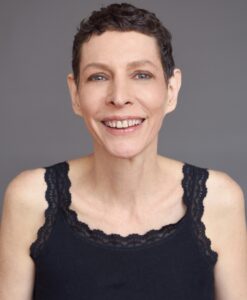 A: I started exhibiting fresh out of art school but my work was sacred and that translated as weird and witchy. This was the 1980’s and angst and fear was in vogue. I did some more conventional pieces to keep the invitations coming back, but it was unsatisfying. All I wanted to do was paint my dreams. So, I dropped out of exhibiting for twenty years and painted a little for myself and dear ones. In 2009 I started dreaming profound and mystic dreams almost nightly for a year and a half. They started spilling out faster than I could paint hem and that got me going again. The paintings kept coming, the exhibits started happening and my role as a professional artist developed.
A: I started exhibiting fresh out of art school but my work was sacred and that translated as weird and witchy. This was the 1980’s and angst and fear was in vogue. I did some more conventional pieces to keep the invitations coming back, but it was unsatisfying. All I wanted to do was paint my dreams. So, I dropped out of exhibiting for twenty years and painted a little for myself and dear ones. In 2009 I started dreaming profound and mystic dreams almost nightly for a year and a half. They started spilling out faster than I could paint hem and that got me going again. The paintings kept coming, the exhibits started happening and my role as a professional artist developed.
I promised myself to work on not getting caught up in the fame and fortune game. It has shown me more than once what an evil little trap it is. For a long time I did things for money and then I painted. Now I can paint and make books and I am making money. But I don’t even sell the paintings of my dreams, so I still keep this part of my creation out of the financial game.
Without a doubt the enjoyment comes from the whole process: the act of making the art, the finishing of it and the enjoyment others might have of it. However as soon as I am concerned about how much it should be liked, as soon as there are expectations, life pulls the carpet out from under me. It asks me ‘do you really want to go down that road again?’
Of course, solo shows, an interview in Miroir magazine, a strong and positive response to a piece of mine, any of this is going to make me happy. The key is that it should not determine my happiness or I set myself up for disappointment in one way or another.
Q: Do you have formal training?
A. If so, what institution did you attend? Do you feel having a degree has helped you be more successful? Did you make any lasting connections at school or find that attending formal institution gave you any advantages you might not have had otherwise?
B. If you are self-taught, do you feel that the lack of formal training has hindered you in any way? Did you find any road blocks due to a lack of a degree? Do you feel there were advantages by not having a formal teacher, such as a unique perspective without other influences?
A: I received a scholarship at the School of the Art Institute of Chicago in 1981 where I got my MFA. I went there to learn how to paint but unfortunately the idea of painting at the time was ‘start and we will have critique on Friday.’ There was 0 training because the philosophy was that if a teacher teaches his own style, the student will never learn hers. Well imagine saying that to the piano student: start. Figure it out and we’ll discuss what you found on Friday.
We can benefit from centuries of trial and error by learning materials and technique. I dropped out of the painting department and studied woodworking, bookbinding and ceramics.
Once I started seriously painting again, I learned a lot of new techniques from artist friends and online. One never stops learning.
Q: What advice do you have for young artists just starting out?
A: My most important pieces of advice to new artists are:
Do not compare yourself to others.
Make art because it is a gift, don’t waste time waiting for a reward.
Study materials and techniques.
Find your own style.
Don’t be scared to start. No better time than now.
Q: Do you feel that the community: local, state or government needs to be more supportive of the arts? If so, in what way?
Have you had the opportunity to benefit from grants or commissions funded by the state or government or private institutions? If so, can you share your experiences?
A: I live in France and we have a pretty good set up for artists, but all countries need to support the arts!
Q: If you could have a conversation with anyone from our past, any era, who would it be and why?
A: Yes, right now I would love to discuss mysticism with a Sumerian priestess from the fourth millennium.
Q: If there is any topic or question, we did not ask, feel free to create your own question and answer for this interview.
A: I hope that my lengthy answers were not too much. I realize you can edit so I thought better too much than not enough.
Liba Waring Stambollion’s websites:
https://www.artwork-liba.com/
https://www.instagram.com/liba_ws/
http://www.dreamsanddivinities.com/



